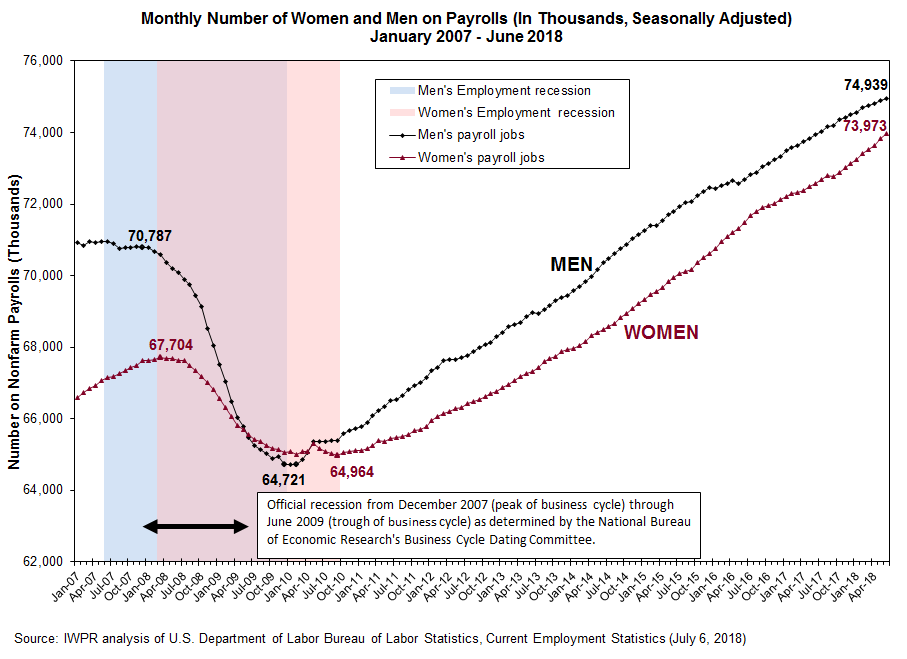
The Institute for Women’s Policy Research (IWPR) analysis of the July employment report from the U.S. Bureau of Labor Statistics (BLS) establishment survey finds that in June women added 153,000 jobs and men gained just 60,000 jobs for a total of 213,000 jobs added to payrolls in June. In the second quarter of 2018 (April-June), men gained 29 percent (181,000 jobs) and women gained 71 percent (451,000 jobs) of all jobs added (632,000 jobs), about the same percentage of jobs women gained in June. According to the household survey, the overall unemployment rate increased to 4.0 in June from 3.8 percent in May.
In June, women gained jobs in Educational and Health Services (56,000 jobs added for women), Professional and Business Services (28,000 jobs), Leisure and Hospitality (15,000 jobs), Government (13,000 jobs), and Financial Activities (11,000 jobs), but lost jobs in Retail Trade (12,200 jobs lost for women). Men gained jobs in Durable Goods Manufacturing (23,000 jobs added for men), Professional and Business Services (22,000 jobs), and Leisure and Hospitality (10,000 jobs), but lost jobs in in Retail Trade (9,400 jobs lost for men) and Wholesale Trade (5,000 jobs). The industries adding the largest numbers of jobs for women in June also show the largest job gains for women in the quarter that just ended (April-June).

Figure 2 shows that in the second quarter of 2018 (April-June), women’s job gains were strongest in Educational and Health Services (126,000 jobs added for women), Professional and Business Services (102,000 jobs), and Leisure and Hospitality (53,000 jobs). Over the same time period, men’s job gains were strongest in Professional and Business Services (50,000 jobs added for men), Construction (48,000 jobs), and Durable Goods Manufacturing (46,000 jobs). Men’s job losses were largest in Government (10,000 jobs lost for men) and Retail Trade (6,000 jobs).
According to the household survey data reported by the BLS, the overall labor force participation rate (which is the sum of the employed and unemployed divided by the total population aged 16 and older) increased to 62.9 percent in June from 62.7 percent in May. In June, women 16 and older had a labor force participation rate of 57.2 percent and men 16 and older had a labor force participation rate of 69.1 percent. Unemployment among women aged 16 and older was 4.0 percent in June compared with 4.1 percent among men aged 16 and older.

Among workers aged 20 and older in March 2018, unemployment is substantially higher among Black women (5.5 percent; Figure 3) and men (6.4 percent) compared with White women and men (3.3 percent for both). Hispanic women’s unemployment (4.8 percent) and Hispanic men’s unemployment (3.8 percent) are also higher than White women’s and men’s unemployment. In the previous year, unemployment declined for Black women (6.8 percent in June 2017 to 5.5 percent in June 2018), Hispanic women (5.2 percent in June 2017 to 4.8 percent in June 2018), White women (3.5 percent in June 2017 to 3.3 percent in June 2018), and White men (3.6 percent in June 2017 to 3.3 percent in June 2018). However, unemployment increased for Black men (6.3 percent in June 2017 to 6.4 percent in June 2018) and remained steady for Hispanic men (3.8 percent in June 2017 and June 2018).
For single mothers (female heads of households residing with at least one family member, but not an opposite-sex spouse), the unemployment rate decreased to 5.5 percent in June 2018 from 6.9 percent in June 2017. The unemployment rate for single mothers is not seasonally adjusted and can fluctuate due to small sample sizes in the household survey.
The number of unemployed workers decreased from June 2017 to June 2018, from 7.0 million to 6.6 million. The number of long-term unemployed workers (those unemployed for 27 weeks or more) decreased to 1.5 million in June 2018—a drop of 1.9 percentage points from 24.9 percent in June 2017 to 23.0 percent of unemployment in June 2018. The number of involuntary part-time workers—those reporting that they work part-time due to unfavorable business conditions, inability to find full-time work, or seasonal declines in demand—was 4.7 million in June 2018, compared with 5.3 million in June 2017.


